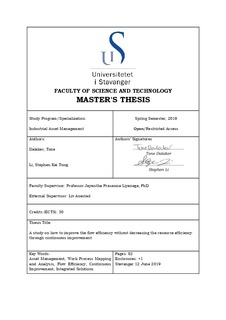| dc.contributor.advisor | Liyanage, Jayantha Prasanna | |
| dc.contributor.author | Li, Stephen Kai Tung | |
| dc.contributor.author | Dalaker, Tone | |
| dc.date.accessioned | 2019-10-08T09:26:00Z | |
| dc.date.available | 2019-10-08T09:26:00Z | |
| dc.date.issued | 2019-06 | |
| dc.identifier.uri | http://hdl.handle.net/11250/2620821 | |
| dc.description | Master's thesis in Offshore Technology; Industrial Asset Management | nb_NO |
| dc.description.abstract | The oil crisis in 2014 forced the oil and gas companies to reduce their spending and increase focus on streamlining their work. Even though there has been an upturn in the oil price since 2014, many companies still find ways to make their operations more efficient and effective. This leads to financial savings, contributing to a more sustainable and competitive organization. In order to improve, companies need to have a clear understanding of their current work processes.
Work process mapping shows the relationship between activities, people, data, and objects. Having a complete map of the organizational workflow creates a better understanding of the processes and their boundaries. This can help stimulate the employees’ involvement and enthusiasm, as well as making them more conscious in their role in the organization and how their effort contributes to the organization’s overall objective.
PRS JV is aiming towards improving their current flow efficiency. To be able to implement measures of improvement, it is necessary to establish its current efficiency. By not having a comparable baseline, it is impossible to measure the effect of implemented improvements. Therefore, this Thesis entails mapping and analysis needed to establish a baseline for comparison. Recommendations are given that aim to increase the flow efficiency and contribute to a culture for continuous improvement. This is achieved by having stepwise targets requiring an increasing level of company engagement. By identifying and making changes to a company’s work processes it is possible to increase value, strengthen the competitive advantage, and maximize profits. | nb_NO |
| dc.language.iso | eng | nb_NO |
| dc.publisher | University of Stavanger, Norway | nb_NO |
| dc.relation.ispartofseries | Masteroppgave/UIS-TN-IMBM/2019; | |
| dc.subject | asset management | nb_NO |
| dc.subject | industrial asset management | nb_NO |
| dc.subject | work process mapping and analysis | nb_NO |
| dc.subject | driftsledelse | nb_NO |
| dc.subject | flow efficiency | nb_NO |
| dc.subject | continuous improvement | nb_NO |
| dc.subject | integrated solutions | nb_NO |
| dc.subject | offshore teknologi | nb_NO |
| dc.title | A study on how to improve the flow efficiency without decreasing the resource efficiency through continuous improvement | nb_NO |
| dc.type | Master thesis | nb_NO |
| dc.subject.nsi | VDP::Technology: 500::Marine technology: 580::Offshore technology: 581 | nb_NO |
